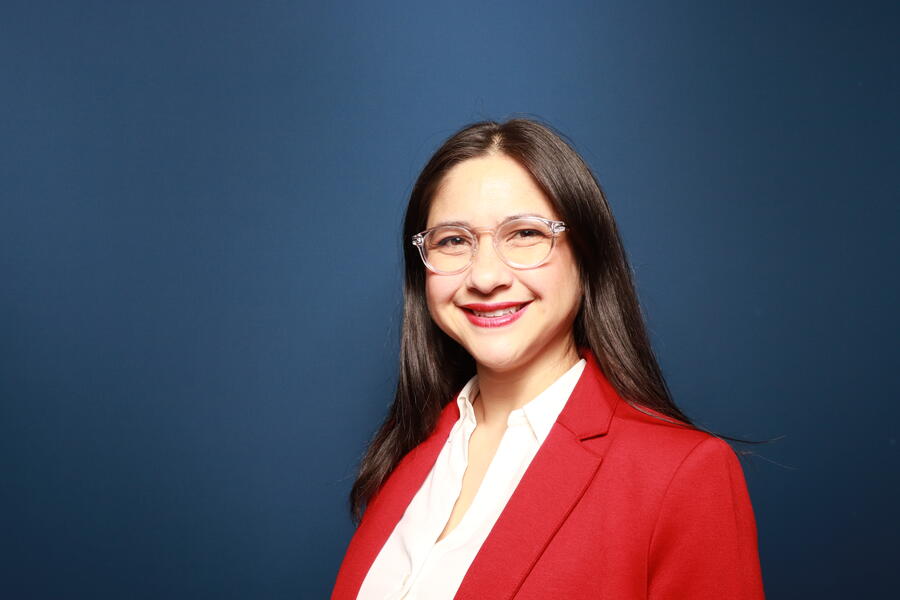Therese Canares, Bus '21 (MBA), a pediatric emergency physician, has a grand vision: to save people from having to make an unnecessary trip to the doctor's office if they think they have strep throat.
Strep throat, a common bacterial infection, is responsible for 5.2 million outpatient visits per year in people under 65, according to the CDC. Not everyone who gets a strep test, however, ends up with a positive diagnosis.
While working on her MBA at Carey Business School, Canares, a pediatric emergency physician, and Mathias Unberath, a computer science professor in the Whiting School of Engineering, began developing a smartphone app called CurieDx that could screen for strep by comparing a photo of the user's throat with artificial intelligence images. In 2021, Canares put her medical career on hold and now works full time as the CEO of CurieDx.
"From our early data, we were finding that doctors and clinicians were only 64% accurate at predicting strep just from looking at the throat," Canares says. "CurieDx has 94% sensitivity and is highly predictive for negative cases, which helps families know when to stay home."
The app is currently available only to physicians and urgent care centers that have a telehealth component. Eventually, the plan is to market it to consumers as well.
Here, Canares talks about the challenges of launching a medical device and why she believes CurieDx will be a game changer for families.
What inspired you to create CurieDx?
I'm a pediatric emergency physician, and working in the emergency room, especially during the pandemic, I would see a lot of families come in and wait three hours to be seen for something that really didn't need the ER in the first place, like coughs and colds and runny noses and sore throats. I was doing research in AI and computer vision, and I wanted to solve this problem and help keep people at home when possible. So, [Matt and] I created a way to predict disease—in this case strep throat—using a smartphone image and AI.
What does CurieDx offer that a telehealth visit can't?
When telehealth started exploding during the pandemic, we saw that there's so many things that you could do on telehealth except for the one missing piece, which is some kind of point-of-care test. We realized that we were filling that gap of providing point-of-care testing data for when patients are home and getting remote care.
How does strep throat in particular lend itself to this kind of app?
There are visual differences in a throat that has a bacterial infection like strep compared to other causes of sore throats like viral infections or allergic pharyngitis, and even strep doesn't always look the same. Sometimes those visual differences are really subtle.
What computer vision does is it learns patterns. It can detect subtleties at a pixel level and see a vastly greater number and variety of images beyond what a physician can feasibly see across their clinical practice.
What challenges did you face while developing CurieDx and getting it up and running?
We had the classic startup challenges. Fundraising and getting funding has been especially difficult because this is considered software as a medical device and it has heavy research and development costs. So, there's more that's needed to bring this to market relative to some other B2B software products.
Other challenges are just collecting data, so getting clinical partners to work with us and help us collect pictures of throats, and then building a team of people who are willing to take a chance on a startup that has a high likelihood of succeeding, in my opinion, but still some uncertainty relative to other career options.
How did you come up with the name for the app?
The name comes from Marie Curie, one of the best inventors and creators of our time who also happened to be female. In addition to her work in radiology and with radiologic isotopes, she created the first portable X-ray device during World War I. Since she did work in imaging and we are doing image-based analysis, I think it was a nice tribute to her and her name and her work. And of course, we're hoping to help families cure disease. So, there's a number of types of symbolism in the name.
Have you gotten any feedback from people who've used the app during the testing phase?
We've had some pilot testers and families try it out, and they've told us things like, "We just started kindergarten this week and I didn't know if I could take my kid to school. This would be a game changer for us and completely change the course of my day," or "If I had had this, I wouldn't have waited three days to take my family member to the doctor." I had one person reach out and say, "Hey, I [think I] have strep throat. Is your app out yet? I need this so badly." The impact that this will have directly on people's lives is so great. It's something that will really make a difference for patients and families.








